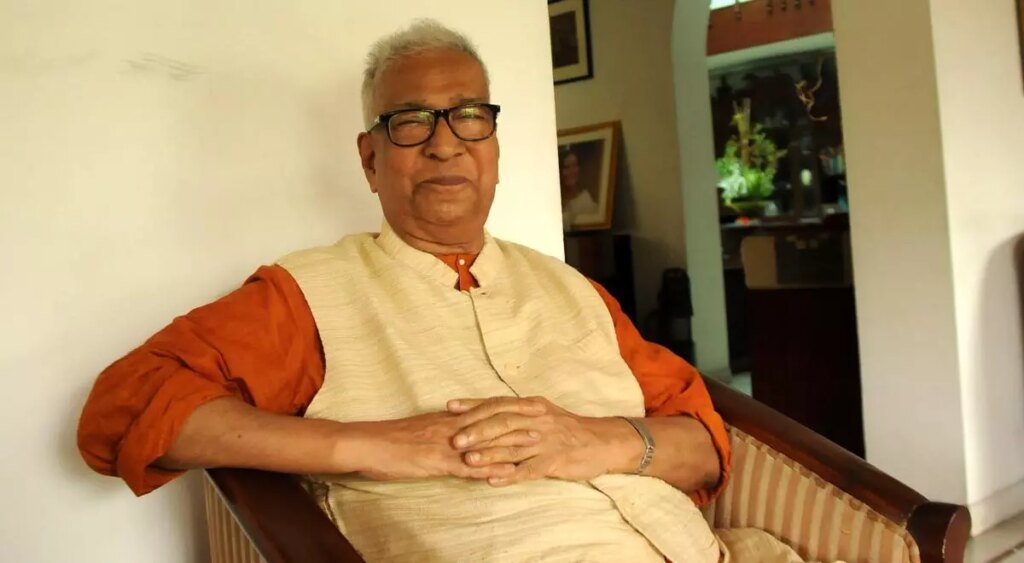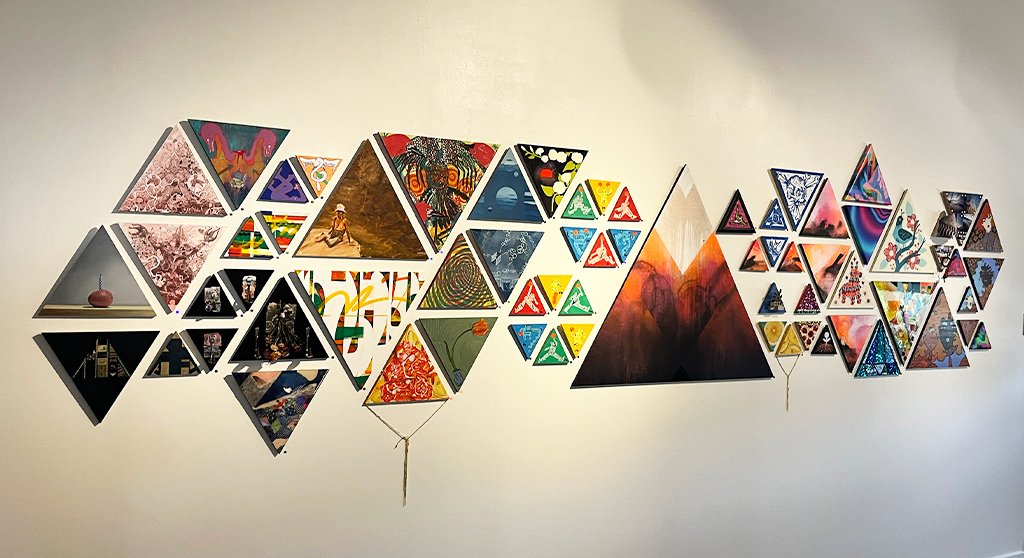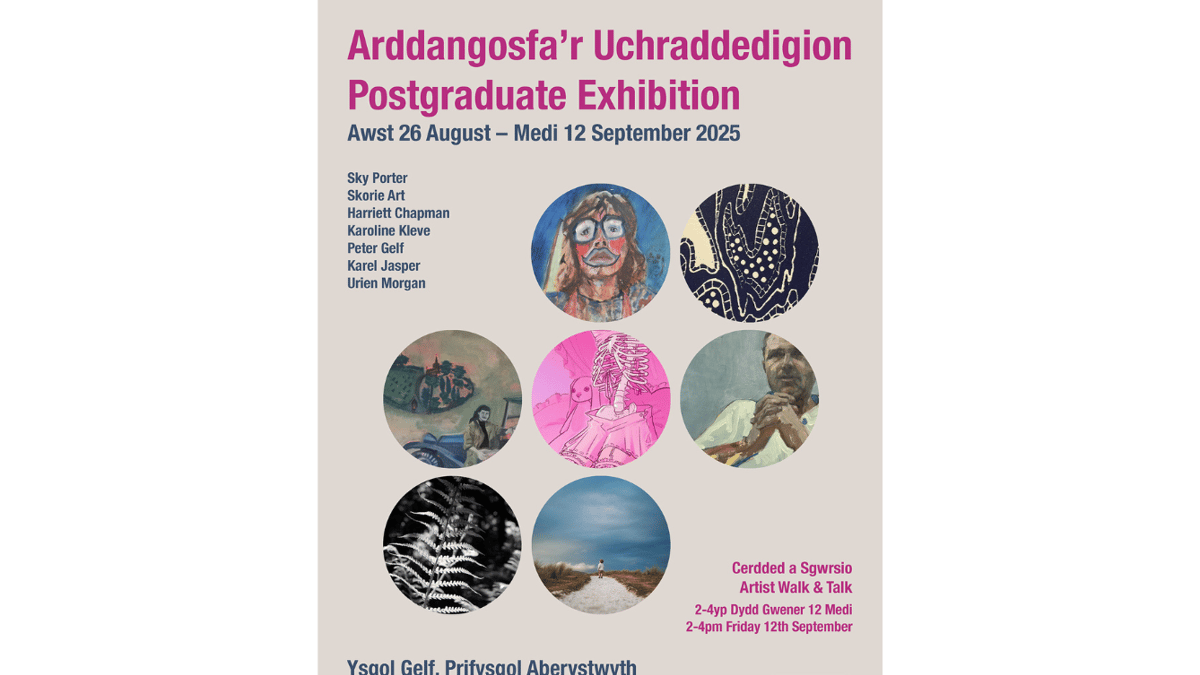The exhibition “One Hundred Years and Counting: Re-Scripting KG Subramanyan” (April 5-June 21), at Emami Art, Kolkata, organised in collaboration with Seagull, and the Faculty of Fine Arts, Maharaja Sayajirao University (MSU), Baroda, is an invigorating, brilliant, and multifaceted celebratory show worthy of the master.
Curated by the cultural theorist Nancy Adajania, it seeks to explore the political philosophy and ideological stance of the artist known for his pluralistic vision and subversive temperament. Spanning more than seven decades of Subramanyan’s practice, the exhibition features the artist’s early paintings from the 1950s, his iconic reverse paintings on acrylic, his postcard-size drawings, toys he made for the Fine Arts Fairs held at MSU between 1962 and 1979, and more.
Instead of displaying the works chronologically, medium or theme-wise, as is usually done, Adajania has chosen to focus on the political content of Subramanyan’s oeuvre, particularly his battle against authoritarianism, in the first of the two vast halls on the ground floor of Emami Art. On the sides of the main show, with its array of large reverse paintings on acrylic that glow like stained glass, there are archival material and photographs. There are also relevant extracts and images from Subramanyan’s books for children, recompensing for the indifference they may have suffered so long simply because they are considered “kids’ stuff”.
Also Read | K.G. Subramanyan (1924-2016): For one to be so many
Critique of Emergency
Adajania writes: “The biting critique of the 1975-1977 Emergency in his children’s book, The Talking Face, enshrines singular reactions to political events.” Vinyl cut-outs of the animated images of children from these books not only cavort on the walls but quite unconventionally also sprawl on the floors. One of them is in free fall, like Icarus; it is from Subramanyan’s children’s book The Tale of the Talking Face, a political fable on the excesses of the Emergency. The curatorial note says: “It is staged as a warning bell in this exhibition for all authoritarian leaders who believe that they are invincible and that their tyrannical regimes can continue forever.”
Rhino. Bamboo, wood and leather, 8.6 x 12.2 x 5.3 (22 x 31 x 13.5 cm.),
1962/63 -1979, Baroda. The toys were made for the Fine Arts Fair, MSU Baroda between 1962/63 and 1979.
| Photo Credit:
Indrapramit Roy/ Emami Art
The feeling of freedom it generates is quite perceptible, reflecting the ease with which Subramanyan appropriated elements from multiple cultures without sparing a thought for geographical boundaries or the chronology of history when he forged his art. In an interview with the Santiniketan-based art historian R. Siva Kumar, Subramanyan had said: “My work, so to say, deconstructs an old concept and sees its similarities with others…. I am by nature a fabulist. I transform images, change their character, make them float, fly, perform, tell a visual story. To that extent my pictures are playful and spontaneous.”
In favour of cultural diversity
Right at the beginning of the exhibition, there is a wall with the depiction of a little boy from one of Subramanyan’s children’s books of poetry. The poem, printed beside the figure, goes: May be / they named me / Robby. / But Pa calls me Baba / Ma calls me Dumpling / Sis calls me Booby / And aunt calls me Silly / But I can be more still / Like the ant in the anthill… Do you think it is funny / For one to be so many?
The rhythm might be childish, but the thought behind it is not: the boy with multiple names is a metaphor for cultural diversity, the hallmark of India, that should be a source of pride for our democracy, and not something that right-wingers can shatter easily to impose their vision of a monolithic culture.
Illustration from the children’s book, Robby (2008), by K.G. Subramanyan.
| Photo Credit:
Emami Art
The mock-ups of a children’s book, How Hanu Became Hanuman, with their illustrations—collages of workaday paper cut-outs made by hand and pasted on a sheet—have never been displayed before.
Subramanyan joined the arts faculty of Visva-Bharati University, Santiniketan, in 1944, when the pioneering artists Nandalal Bose, Benode Behari Mukherjee, and Ramkinkar Baij were working there. With them as his mentors, he heaved a sigh of relief. They may have taken their art seriously but not themselves.
Bose could easily turn into a doting grandfather when it came to entertaining his adoptive granddaughter, making tiny paper collages for her. In his collages, Bose poked fun at the Anglicised girls of the Dow Hill School of Darjeeling and at the crone wearing a coquettish bow on her hat. One of these is on display alongside Benode Behari Mukherjee’s colourful paper cut-outs. Unlike the modernists of Europe, Bose was reverting to child art only to keep a little girl happy. Rabindranath Tagore, too, would write Se (“He”, published in 1937) for his granddaughter, Pupe didi, and illustrate it with line drawings of enigmatic but humorous figures, in keeping with the spirit of the work that hovered midway between fact and fantasy. Subramanyan’s friend at Santiniketan, the shadowgrapher Prasanna Rao, is also present at the exhibition. This detailing adds to its flavour.
As do the brilliant black-and-white photographs by Jyoti Bhatt of the activities at MSU when Subramanyan joined it as a lecturer in 1951. The first one exhibited here shows the artist Pushpamala N. masquerading as a commedia dell’arte character and her classmate Walter D’Souza wearing fanged dentures while performing a skit. The sculptor Mrinalini Mukherjee, in a colour shot, is engaged quite literally in horseplay.
Gandhian and Marxist influence
Subramanyan had stated emphatically: “My choice will be to be an artist activist—not an activist artist.” As a student he came under the influence of Marxist philosophy. But he found Gandhian philosophy more acceptable. As a student leader of Presidency College, Madras, he was arrested and jailed for six months for picketing the Secretariat in 1943 in the heat of the Quit India movement.
Maquette for the mural, War of the Relics. Paper cutout and gouache on paper, 11.75×12 in., 2012. Signed in Tamil (lower right).
| Photo Credit:
Emami Art
The 36 ft by 9 ft mural, War of the Relics, that Subramanyan created for the India Art Fair in 2013 exposes the emptiness of all that we hold sacred: this massive black-and-white work is a meditation on the futility of violence. The maquette displayed here shows 16 canvas panels divided into 8 diptychs, painted in black acrylic and oil on a white background, as in the giant Kala Bhavana mural in Santiniketan. This was his final mural; Subramanyan died in 2016.
Central to his “polymorphic” paintings is the idea of the bahurupee, ordinary villagers impersonating a god or a goddess, sometimes with as many arms as a centipede, the guise endowing them with supernatural powers. Subramanyan wrote: “Between these village boys and the mythical stereotypes a new reality is born. Mixing the normal with the hieratic. Mixing the worldly with the unworldly. Or fact with fantasy.”
Polyptich 3, Watercolour and oil on mylar sheet, 42×32.5 in, 1998. Each signed in Tamil.
| Photo Credit:
Emami Art
His goddess Durga is a hybrid that emerged from the Indian subconscious, bearing traces of her forerunners like the Babylonian goddess Ishtar and the mother goddess of Asia Minor, Cybele, as well as of figures from our folk paintings. She is the armed demon slayer who breaks into a frenzied war dance like the irrepressible Tina Turner or like the bahurupee, the “poor, bare, forked animal”. Subramanyan effortlessly negotiated the hieratic and the plebeian. A clip from Ritwik Ghatak’s Subarnarekha in which a bahurupee in a goddess’s garb reveals his true self to a little girl, much to her consternation, emphasises this duality in Subramanyan’s art.
What Ghatak had said in an interview about his cinema applies equally to Subramanyan: “There is an epic tradition which dominates the Indian mentality. It has seeped into the Indian subconscious. It is no surprise that Indians are attracted to mythologicals. I am a part of it. I cannot think of myself without the epic tradition. I am all for it. It is in our civilisation since time immemorial. In my films I rely mainly on the folk form. The Great Mother in its duality exists in every aspect of our being…”
Highlights
- The exhibition “One Hundred Years and Counting: Re-Scripting KG Subramanyan” (April 5-June 21), at Emami Art, Kolkata, is a brilliant show worthy of the master in his centenary year.
- Curated by Nancy Adajania, it seeks to explore the political philosophy and ideological stance of the artist known for his pluralistic vision and subversive temperament.
- Adajania focusses on Subramanyan’s murals and critiques his depiction of women. The exhibition also examines the toys Subramanyan fashioned during his tenure at MSU, Baroda.
Grandly rambunctious
Subramanyan’s grandly rambunctious paintings are not meant for those who have a horror of concupiscence. Both the human and the animal world seem to be in rutting season, genitalia blooming like flowers. This should not surprise those who have walked through the archaeological gallery of the Indian Museum in Kolkata with its array of barely clad deities. The erotic charge is quite perceptible, and many viewers walk away in embarrassment as the graphic depictions of sexual arousal confront them.
Untitled: Pen, ink and watercolour on paper, 13×7 in., 1958, unsigned.
| Photo Credit:
Emami Art
In an adjoining second hall, Adajania focusses on Subramanyan’s murals and critiques his depiction of women. Subramanyan’s political philosophy, gleaned from the ideas of both Rabindranath Tagore and Mahatma Gandhi, is laid bare through the documentation and “decoding” of four of the murals he had created; their preparatory sketches are displayed too.
Interestingly, Adajania draws attention to the prominent “seed-vulva connection” in the drawings and to the representation of “Kamdhenu, a symbol of fertility and prosperity” in the Gandhi Darshan mural, which he made for the centenary exhibition of Gandhi in Rajghat, Delhi, in 1969.
“Love-hate relationship towards the female body”
The display in the second hall begins with Subramanyan’s early paintings from the 1950s. Two intriguing works stand out. A blue boy in a yellow dhoti plays the flute as he watches a nubile maiden undress. She stares back unflinchingly. The calmly voluptuous scene could easily have been inspired by Stéphane Mallarmé’s poem, “L’Après-midi d’un faune” (“The Afternoon of a Faun”), which was the stimulus behind Claude Debussy’s Prelude.
Figure and Faces, Gouache on handmade paper, 31 x 22.5 in., 2008. Signed in Tamil (lower left).
| Photo Credit:
Emami Art
In the second mixed-media drawing, a woman stands ramrod straight, head held high and arms by her side. Seen from a horizontal angle, it could easily have been a cadaver waiting to be dissected. The cold detachment with which she is observed is rare in Subramanyan. In striking contrast is the colourful painting of the grande horizontale in all her finery.
Depicted in shades of indigo and brown is a suite of mother-child paintings that cannot be missed for it is an inversion of the calendar images of Krishna in the lap of Yashoda. The monstrous children—one has multiple eyes—hungrily latch themselves on to the breasts of their suckling mother. The ferocity of the act drives away all sweet and sentimental thoughts.
Untitled, Gouache on paper, 14.5 x 21.5 in.,1955. Unsigned.
| Photo Credit:
Emami Art
Adajania writes that Subramanyan “exhibits a love-hate relationship towards the female body, feeling passionate about it as well as being overwhelmed by its sexuality”, adding that “[a]t one level, his approach to the rendering of the female body is no different in temperament from what could be called the centuries-old ‘Susanna and the Elders’ syndrome”. Voyeuristic, in other words. As a feminist, Adajania’s reading is perhaps an expected one.
Also Read | The quintessential Indian artist
However, she also acknowledges Subramanyan’s generosity towards students such as Pushpamala N. and Mrinalini Mukherjee, whose talents bloomed under his guidance. In this context, it is necessary to appreciate Subramanyan’s contributions as a teacher: he is widely remembered for nurturing the talents of his students, enabling them to come into their own.
The Reaper, Watercolour and oil on acrylic sheet, 75×51 in., 1998. Signed in Tamil (lower left).
| Photo Credit:
Emami Art
The exhibition rounds off with an examination of the relationship between Abanindranath Tagore’s whimsical kutum katam figures and the toys Subramanyan fashioned during his tenure in Baroda. These toys were made with the help of Gyarsilal Varma, Subramanyan’s craftsperson colleague from MSU, who was an expert in making murals as well as stone and ivory carving. While Abanindranath’s kutum katam, those intriguing shapes made of driftwood, were meant to entertain his grandchildren, Subramanyan’s carefully crafted toys are not child’s play at all. Both artists were phenomenally inventive, but temperamentally, they could not have been more different. Abanindranath’s ineffable, blithe spirit resists translation.
What is remarkable about the exhibition is the way it challenges viewers to take a more critical look at Subramanyan’s vast repertoire. Examining his legacy helps reaffirm the versatile, incisively witty, and erudite artist’s continued relevance to our times and to new generations of art practitioners.
Soumitra Das is a freelance journalist based in Kolkata.






